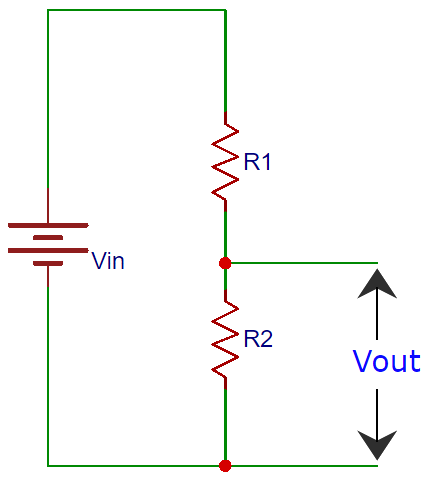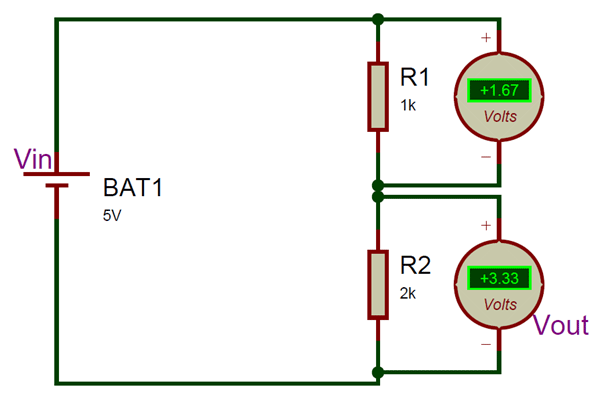
Please see the voltage divider circuit provided here and calculate the output voltage using the voltage divider calculator according to the following voltage divider formula:
Alternatively, you can also use this voltage divider circuit calculator to provide any 3 known values in the circuit and calculate the 4th one.
Here:
- Vin is the input voltage
- R1 is the resistance of the 1st resistor,
- R2 is the resistance of the 2nd resistor,
- Vout is the output voltage.
How to use this Voltage Divider Calculator?
Our Voltage Divider Calculator helps you to determine the perfect resistor values or voltages for your circuit. Follow these simple step to use our voltage divider calculator
Choose Your Known Values
The calculator has four fields namely, Input Voltage (Vin), Resistance 1 (R1), Resistance 2 (R2), and Output Voltage (Vout). Out of these four values, the user has to input at least 3 values. When you click on calculate, the calculator will automatically compute the fourth value for you
Pay Attention to Units
Please pay attention to the unit. For Voltages use Volts (V). For resistance choose between Ohms (Ω), Kilohms (kΩ), or Megaohms (MΩ).
How Does Voltage Divider Calculator Work?
A potential divider circuit is a very common circuit used in electronics where an input voltage has to be converted to another voltage less than it. This circuit is very useful for all analog circuits where variable voltages are required, hence it is important to understand how this circuit works and how to calculate the values of Resistors.
A voltage divider circuit is very simple circuit consisting of only two resistors (R1 and R2) as shown above. The required output voltage (Vout) can be obtained across the resistor R2. Using these two resistors we can convert an input voltage to any required output voltage, this output voltage is decided by the value of the resistance R1 and R2. The formulae to calculate Vout is shown below.
Vout= (Vin x R2) / (R1 + R2)Where, Vout= Output Voltage Vin=Input Voltage and R1=Upper Resistor R2=Lower resistor
We can use the above voltage divider calculator to calculate any one of the value mentioned in the voltage divider formulae, but now let us learn how this formulae was derived. Consider the below circuit which can be used to convert 5V input to 3.3V output for analysis

To understand how a potential diver formula is derived we need Ohms law calculator , according to Ohms law the voltage drop across any location is a product of the current flowing through the circuit and the Resistance across it.
Voltage = Current Flowing through × Resistance across the voltage
Let us use this to calculate the Input Voltage (Vin) for the above circuit. Here there are two resistors across input voltage Vin, hence
Input Voltage = Current × (Resistance 1 + Resistance 2)
Vin = I × (R1 + R2) (1)Similarly let us calculate for output voltage (Vout), here there is only one resistor (R2) across it hence
Output Voltage = Current × Resistance R2
Vout = I × R2 (2)If we look at the equation 1 and 2 we can notice that the value of current is same, hence lets re-write
Equation 1 as, I = Vin / (R1 + R2)
Equation 2 as, I = Vout /R2
Since the current flowing through the circuit is constant, the current I will remain same for both the equations hence we can equate them as
Vin / (R1 + R2) = Vout /R2
Vout= (Vin x R2) / (R1 + R2)Example Calculation
Let us test this voltage divider formulae for the above circuit where Vin =5V, R1 = 1000ohms and R2 = 2000ohms.
Vout = (5×2000) / (1000/2000)
Vout = (10000) / (3000)
Vout = 3.3333V
Common Application with Solutions
Let's consider a common application in microcontroller circuits where the input voltage (Vin) is 5V and the desired output voltage (Vout) is 3.3V. If we fix the value of R1 at 1kΩ, which is a commonly available resistor, and click on calculate the resulting value for resistor R2 is 1.94kΩ. Now practically we will not have a resistor with value 1.94kΩ so we will use the closest available resistor which 2kΩ
One more common application is in battery voltage division, say we have a 9V battery and our desired output voltage is 5V. Then our Vin is 9V and Vout is 5V. Again if we fix the value of R1 at 4.7kΩ and calculate using this voltage divider resistor calculator, the resulting output for R2 will be R2 = 6.8kΩ. In this case the resistor 6.8kΩ itself is available so we can directly use it.
Power Rating Considerations
Another important factor to consider while selecting the resistor values is its power rating (P). Once you know the values of I (based on load), Vin, R1, and R2, add R1 and R2 together to get RTOTAL and use the Ohms law calculator to find out the power(Watts) rating required for the resistors. Or simply use the formulae P=VI to decide on the power rating for your resistor. If a proper Power rating is not selected the resistor will overheat and might also burn.
Tips for Accurate Results
This online voltage divider calculator is highly reliable for a wide range of calculations and applications. But here are few tips to make sure we get the most accurate results not just on the calculator but also when you actually build the circuit practically.
Voltage Constraints: The input voltage must be greater than the output voltage and all values must be positive number. The maximum voltage should not be more than 1000V for safety purposes
Resistance Selection: Always use standard resistor values when possible. Consider resistor tolerance (1% or 5%) in your final output, lower tolerance resistor will practically give close to the expected results. Also, remember that higher resistance values reduce power consumption and lower resistance values increase power consumption but provide better stability.
Common Mistakes to Avoid: Don't forget to match units and consider power dissipation. Consider the output power requirement of your load and make sure the your resistance can handle the current required for your load. Remember temperature effects, if the resistor gets hot its resistance value will drop resulting in a different output voltage.

